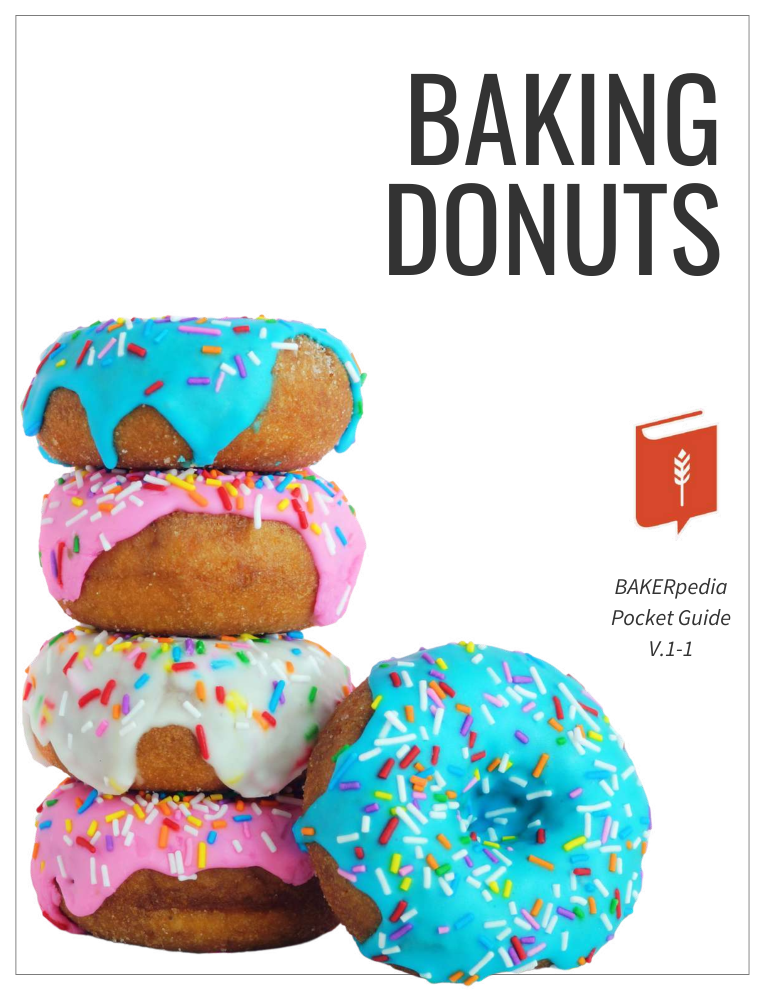The Secret to Delicious Donut Production

With their sweet flavor and soft texture, donuts are among the most versatile bakery items. They are enjoyed at breakfast, as snacks, and even as components of sandwiches. This beloved treat can be fried or baked, yeast-leavened or chemically leavened, and comes in various forms to satisfy diverse tastes.
Donuts Pocket Guide
To learn more, download the guide:

The Expanding Donut Market
The donut market is thriving, valued at USD 12 billion in 2023, and projected to grow at a 7% CAGR through 2031¹. Yeast donuts dominate this market, though cake donuts also have a significant following. The increasing demand for healthier baked goods is driving innovation and expanding market opportunities.
Types of Donuts
Yeast-Leavened Donuts: These are made from a lean, sweet dough leavened by yeast fermentation, resulting in a light, airy texture and soft crumb. They are less sweet and tender compared to cake donuts.
Cake Donuts: Made from a batter and leavened with baking powder or soda, these donuts have a dense, cake-like texture. Cake flour, often chlorinated for increased water absorption and a finer crumb structure, is ideal for these donuts.
Key Ingredients
- Flour: Provides structure and texture. In yeast-leavened donuts, it supports gas retention, while in cake donuts, it acts as a bulking agent.
- Sugar: Adds sweetness, moisture, and aids in browning through the Maillard reaction.
- Fat: Tenderizes by coating flour particles, restricting gluten formation, and adding flavor and moisture. Common fats include vegetable oils, margarine, butter, and palm shortening.
- Yeast: Crucial for yeast-leavened donuts, it produces gasses through fermentation, contributing to volume and texture.
- Chemical Leavening Agents: Used in cake donuts, they produce carbon dioxide, affecting volume, density, and texture.
- Eggs: Provide foaming ability, structure, moisture, and contribute to the Maillard reaction for browning.
- Water: Hydrates ingredients, facilitates gluten development, and contributes to the dough’s cohesiveness and final texture.
Processing Techniques
How do cake and yeast donuts differ? Beyond the use of batter versus dough, there are also key differences in processing. Let’s take a closer look:
Yeast-Leavened Donut Production:
- Scaling/Metering: Accurate measurement of ingredients.
- Dough Mixing: Mixing time depends on flour strength, mixer speed, and batch size. The final dough temperature should be 26–28°C (78–82°F).
- Bulk Fermentation: Dough ferments at ambient conditions until it doubles in size, providing rest and relaxation.
- Makeup: Dividing dough into blocks, then sheeting and cutting into shapes.
- Final Proofing: Proofing at 35–43˚C (90–110˚F) with 40–70% RH for 30–40 minutes.
- Frying: The dough is partially immersed in oil at 190–196°C (375–385°F). Due to gas expansion and water evaporation, it floats.
- Glazing: Applied when exiting the fryer, often with high-pressure or rotary nozzles in high-speed processes.
- Cooling: Cooled to 35-40°C (95–105°F) before packaging to retain moisture.
- Icing: Adds flavor and texture, applied mostly by hand.
- Dusting/Coating: Use pulverized dextrose or confectioner’s sugar for a cooling mouthfeel.
- Packaging: Immediate packaging retains moisture and improves shelf life.
Cake Donut Production:
- Scaling/Metering: Precise measurement of ingredients.
- Blending: Ingredients are blended and scaled.
- Mixing: Mix at low and then higher speeds to incorporate ingredients evenly. The final batter temperature should be 21–24°C (70–75°F).
- Cutting/Depositing: Some batters are homogenized before being deposited into hot oil.
- Frying: Partial immersion in oil at 190–195°C (375–385°F) for 45–60 seconds per side.
- Glazing, Cooling, and Icing: Similar to yeast-leavened donuts, with specific cooling and icing steps to ensure quality.
Enhancing Donut Production
So, what’s the key to consistently producing delicious donuts? To maintain consistent flavor, texture, and quality in donut production, consider the following:
- Ingredient Quality: Use high-quality ingredients for consistent results.
- Temperature Control: Monitor and control temperatures during mixing, fermentation, and frying to prevent issues like excessive oil absorption.
- Processing Conditions: Optimize mixing times, proofing conditions, and frying times to enhance texture and flavor.
Donuts offer a delightful array of textures and flavors, making them a favorite for various occasions. Whether you prefer yeast or cake donuts, understanding the technical aspects of their production can help you create the perfect donut every time.
Sources:
-
Nisha Deore, Cognitive Market Research. “Doughnuts Market Size Was USD 12 Billion in 2023!” Cognitive Market Research, 18 May 2024, www.cognitivemarketresearch.com/doughnuts-market-report. Accessed 26 May 2024.
Want to stay up-to-date with BAKERpedia? Sign up for our newsletter today!

